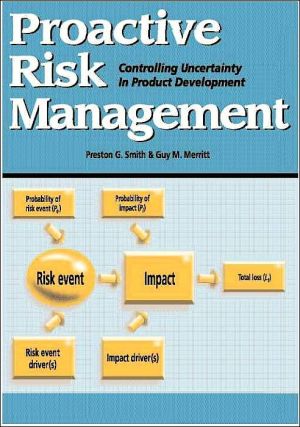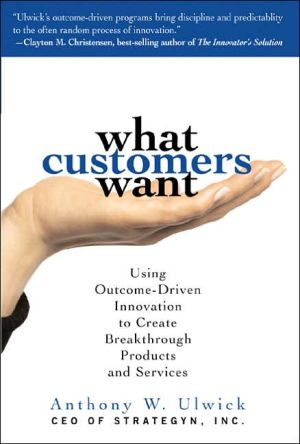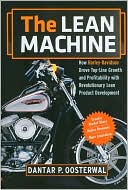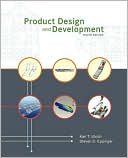Proactive Risk Management: Controlling Uncertainty in Product Development
Listed as one of the 30 Best Business Books of 2002 by Executive Book Summaries\ Proactive Risk Management's unique approach provides a model of risk that is scalable to any size project or program and easily deployable into any product development or project management life cycle. It offers methods for identifying drivers (causes) of risks so you can manage root causes rather than the symptoms of risks.\ Providing you with an appropriate quantification of the key factors of a risk allows you...
Search in google:
This guide for managers offers a proactive approach to the control of risk and provides explicit instructions for implementing risk-management measures. The book details a model of risk which is scalable to any size project or program, and outlines methods for identifying causes of risk, prioritizing risk factors, and overcoming organizational impediments to risk management. Smith is a management consultant; Merritt is a staff program manager with a private corporation. Annotation c. Book News, Inc., Portland, OR Booknews This guide for managers offers a proactive approach to the control of risk and provides explicit instructions for implementing risk-management measures. The book details a model of risk which is scalable to any size project or program, and outlines methods for identifying causes of risk, prioritizing risk factors, and overcoming organizational impediments to risk management. Smith is a management consultant; Merritt is a staff program manager with a private corporation. Annotation c. Book News, Inc., Portland, OR (booknews.com)
PrefaceIntroductionCh. 1What Is Risk and How Is It Managed?1Ch. 2Using Project Risk Models17Ch. 3The Risk Management Process29Ch. 4Step 1 - Identifying Project Risks43Ch. 5Step 2 - Analyzing Risks61Ch. 6Step 3 - Prioritizing and Mapping Risks85Ch. 7Step 4 - Planning Resolution of Targeted Risks101Ch. 8Step 5 - Monitoring Project Risks121Ch. 9Risk Management Toolkit145Ch. 10Risk Management Approaches and Strategies163Ch. 11Implementing a Project Risk Management Program Successfully177Ch. 12Case Studies from Allied Fields193Glossary209Index213
\ BooknewsThis guide for managers offers a proactive approach to the control of risk and provides explicit instructions for implementing risk-management measures. The book details a model of risk which is scalable to any size project or program, and outlines methods for identifying causes of risk, prioritizing risk factors, and overcoming organizational impediments to risk management. Smith is a management consultant; Merritt is a staff program manager with a private corporation. Annotation c. Book News, Inc., Portland, OR (booknews.com)\ \ \ \ \ Soundview Executive Book SummariesThough most companies use some variation of stage-gate product development, they still expend little effort on risk management. Project managers identify risks before the initial gate, but ignore them instead of managing them effectively. The project experiences needless surprises in schedule, cost, budget or market acceptance late in the game, when the same problems have happened many times before.\ Proactive Risk Management enables product development teams to enhance their management of project risks by helping them to identify risks early and manage them to diminish disruption throughout the project. Using a practical, easy-to-use, fact-based approach, Preston Smith and Guy Merritt help developers manage all the risks associated with a project. Although this process is tailored to commercial product development, it is applicable to many other types of projects with some adaptation.\ Risk is a loaded term, so think of risks as surprises. This book is about managing surprises in a project environment. A surprise could be an engineering design that fails in field trials, an unexpected competitor or an accounting error. The authors define risk as the possibility that an undesired outcome -- or the absence of a desired outcome -- disrupts your project. Risk management is the activity of identifying and controlling undesired project outcomes proactively.\ Risk management is an integral part of project management, and product development inevitably requires project management. The authors write that risk management should occur as naturally as managing a schedule, but generally it gets lost in the crunch to get the new products out the door. The authors' goal with this book is to build innate project risk management methodology into an organization.\ Every Project Decision Involves Risk\ Risk is inherent in product innovation, and therefore every decision about a project involves risk because there is always information we will not have until further downstream. Businesses assume certain risks because of today's increased focus on time-to-market. But importance of time-to-market also makes the schedule delays caused by unmanaged risks less tolerable.\ Risk management always deals with uncertainties, whether or not the risk will happen. You will only know for certain that the risk occurs when it happens -- when it ceases to be a risk. Uncertainty cannot be eliminated, but the authors write that it can be narrowed by:\ \ Clarifying the probability of occurrence of risk.\ Understanding the consequences or alternatives of the risk event happening.\ Determining what drives the risk -- which factors influence its magnitude and likelihood of occurrence.\ \ \ \ \ No matter how well you execute risk management, some risks will still occur. Uncertainty can only be reduced, not eliminated.\ The authors warn that risk should not be confused with issues, which are events that are certain to occur. Issues are just as important as risks, but you are aware of them before they arise and they are handled differently than risks.\ The five steps that make up the authors' risk management plan are:\ \ Identifying Risks and Impacts\ Analyzing Risks\ Prioritizing and Mapping Risks\ Planning Resolution\ Monitoring Project Risks\ \ \ \ \ What Is a Risk?\ Risks always involve the possibility of loss. We manage risk because we do not want to suffer loss, even if it is a remote possibility. If there is no possibility of loss, there is no reason to manage the risk. The authors remind developers to consider the possibility that the outcome of certain risks might be a gain instead of a loss.\ The authors write that developers must be aware of the time component of risks. Eventually there comes a time when a risk no longer exists because you have suffered the loss or the risk has been resolved to cause little damage. You must recognize when the risk is gone, so you can remove it from your agenda. Some risks have no time component and are ongoing. If that is so, they are more risks of being in business than risks of this particular project.\ Companies fail at risk management because they fail at one of the two fundamentals of managing risk well: cross-functionality and proactiveness.\ Companies make the mistake of believing that innovation is only in research and development (R&D). However most development project risks fall outside of R&D. The authors warn managers that leaving all risk management in R&D will leave a project wide open for most cross-functional risks.\ The authors write that companies that are not proactive about risk management make two mistakes. They wait until late in the project when risks start occurring and they let risk management lapse. They write that risk management should begin early in a project and proceed as a monitoring and follow-up effort throughout.\ Why Soundview Likes This Book\ Proactive Risk Management stands out as an important guidebook for developers because the five-step process it describes provides clear instructions for those who need to effectively manage risk. Although the five-step process must be used in its entirety to make risk management work for any project, the authors' guidance is broad enough so companies can streamline or modify the process to suit their own needs. The authors also offer a useful risk management toolkit that includes many tools and tips that can help support the process of identifying and managing risks. Copyright (c) 2002 Soundview Executive Book Summaries\ \ \








